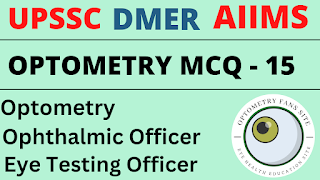Ophthalmology and optometry mcq series part 15
1. Earliest field defect in angle glaucoma:
a. Paracentral scotoma
b. Ring scotoma
c. Seidel scotoma
d . Arcuate scotoma
2. Iridocorneal Endothelial syndrome is associated with:
a. Progressive iris atrophy
b. Bilateral stromal edema of cornea
c. Deposition of collagen in the Descemet's membrane
d. Deposition of glycosaminoglycan in the Descemet' s membrane
3. Malignant glaucoma is seen in:
a. After intraocular surgery
b. Intraocular malignancy
c. Trauma
d. Thrombosis
4. Malignant glaucoma, correct statements are:
a. Anterior chamber is normal
b. Misdirected aqueous flow
c. Pilocarpine is the drug of choice
d. Management is medical only
e. Atropine is the drug of choice
5. Neovascularization of iris is seen in all except:
a. CRVO
b. Diabetic retinopathy
c. Fuchs heterochromic iridocyclitis
d. Congenital cataract
6. The laser procedure used for treating rubeosis iridis is:
a. Goniophotocoagulation
b. Panretinal photocoagulation
c. Laser trabeculoplasty
d. Laser iridotomy
7 . A 25 year old patient presents with painless red eye with an lOP of 60 mm Hg. What is the most likely diagnosis?
a. Chronic papilloedema
b. Acute angle closure glaucoma
c.Glaucomatocyclitic crisis
d. Acute anterior uveitis
8. Krukenberg spindle is seen in:
a. Pigmentary glaucoma
b. Sympathetic ophthalmitis
c. Retinitis pigmentosa
d. Chalazion
9. Krukenberg spindle is seen in:
a. Corneal endothelium
b. Retina
c. Lens
d. Conjunctiva
10. Which of the following drugs is not use topically for the treatment of glaucoma?
a. Timolol
b. Latanoprost
c. Acetazolamide
d. Dorzolamide
11. Contraindications for topical beta-blockers are:
a. Hypertension
b. Asthama
c. Tachycardia
d. Hypotension
e. Depression
12. Which of the following anti-glaucoma medications can cause drowsiness?
a. Latanoprost
b. Brimonidine
c. Timolol
d. Dorzolamide
13. Which anti-glaucoma medication is unsafe in infants?
a. Titnolol
b. Brimonidine
c. Dorzolamide
d. Latanoprost
14. Latanoprost acts in glaucoma by:
a. Decreasing aqueous humour production
b. Increasing uveoscleral outflow
c. Increasing trabecular outflow
d. Releasing pupillary block
15. Which of the following topical drugs causes heterochromia iridis?
a. Latanoprost
b. Prednisolone
c. Olopatadine
d. Timolol
16. Which of the following drugs is not used in a patient of acute congestive glaucoma having a history of sulfa allergy?
a. Glycerol
b. Acetazolamide
c. Mannitol
d. Latanoprost
17. Which drug is contraindicated in uveitis
a. Beta blockers
b. Mydriatic
c. Miotics
d. Carbonic anhydrase inhibitors
18. Hyperosmotic agents act by:
a. Increasing aqueous outflow
b. Decreasing aqueous production
c. Decreasing vitreous volume
d. Increasing uveoscleral outflow
19. Which of these drug combinations is not generally used in glaucoma?
a. Timolol + Latanoprost
b. Timolol+ Brimonidine
c. Timolol+ Pilocarpine
d. Pilocarpine + Latanoprost
20. Laser trabeculoplaso/ is indicated in:
a. Neovascular glaucoma
b.Pseudoexfoliation glaucoma
c. Chronic angle closure glaucoma
d. Uveitic glaucoma
21. The capsule of the crystalline lens is thinnest at:
a. Anterior pole
b. Posterior pole
c. Equator
d. None
22. Ascorbate and Alpha Tochopherol are maintained in the lens in reduced state by:
a. Glucose
b. Glycoprotein
c. Glutathione
d. Fatty acids
23. Which of the following does not handlefree radicals in the lens?
a. VitaminA
b. VitaminC
c. Vitamin E
d. Catalase
24. The crystalline lens derives its nutrition from:
a. Blood vessels
b. Connective tissue
c. Aqueous and vitreous
d. Capsule of the lens
25. Transport of ascorbic acid in the lens is done by:
a. Myoinositol
b. Choline
c. Taurine
d. Na-K ATPase
For Answers key of above question Get Answer key 🔐 Require premium account
Or
Watch videos to Answer key 🗝️
Download Optometry MCQ Series - 11 PDF with Answer key Click below 👇 🔗

